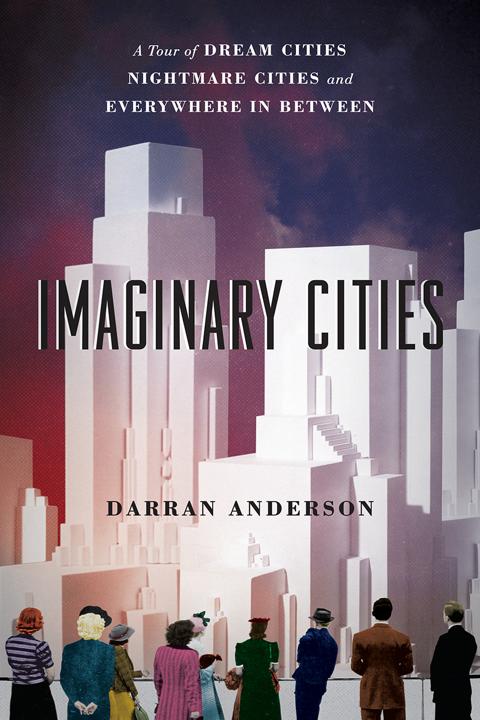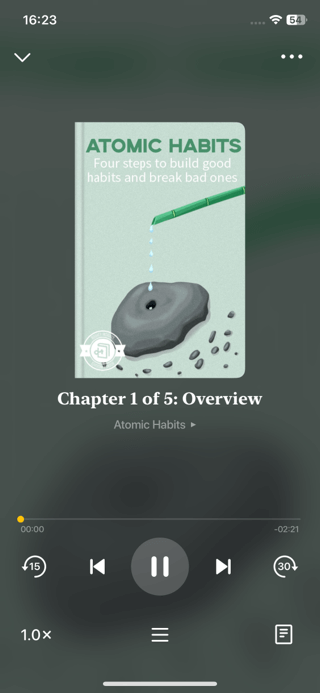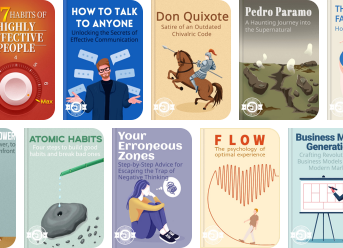Last updated on 2025/07/14
Imaginary Cities Summary
Darran Anderson
Exploring the dreams and myths of urban landscapes.
Last updated on 2025/07/14
Imaginary Cities Summary
Darran Anderson
Exploring the dreams and myths of urban landscapes.
Description

How many pages in Imaginary Cities?
572 pages
What is the release date for Imaginary Cities?
In "Imaginary Cities," Darran Anderson takes the reader on a mesmerizing journey through the labyrinth of human imagination, where fantastical metropolises emerge as reflections of our hopes, fears, and dreams. Blending rich historical narratives with crystallized visions of potential futures, the author explores how cities, both real and dreamt, shape our identities and ambitions. From the utopian ideals of ancient civilizations to the dystopian echoes of modernity, Anderson crafts a tapestry woven from literature, philosophy, and urban theory, inviting us to reconsider the spaces we inhabit and the limitless possibilities that lie within our collective consciousness. This is not merely a book about cities; it is a profound meditation on the very essence of civilization itself, beckoning readers to step into realms where imagination knows no boundaries and urban landscapes transcend the ordinary.
Author Darran Anderson
Darran Anderson is a versatile Irish writer and critic known for his profound insights into the interplay of urbanism and culture. With a background in literature and a keen interest in the philosophies of space and place, Anderson's work often transcends traditional genre boundaries, blending elements of memoir, criticism, and imaginative exploration. His previous publications, including acclaimed works on cities and architecture, underscore his ability to articulate complex ideas in a captivating manner. In "Imaginary Cities," Anderson invites readers on a thought-provoking journey through both real and fantastical urban landscapes, employing his distinctive narrative style to challenge perceptions of the cities we inhabit and their myriad possibilities.
Imaginary Cities Summary |Free PDF Download
Imaginary Cities
chapter 1 | The Men of a Million Lies, or How We Imagine the World
In the evocative first chapter of "Imaginary Cities" by Darran Anderson, titled “The Men of a Million Lies, or How We Imagine the World,” the author embarks on a profound exploration of the intertwined nature of perception, memory, and imagination through the lens of both historical examples and imaginative constructs. Here are the key points derived from the text: 1. Origins of Imagination: Before cinema as we know it, ancient forms of shadow play illuminated the interplay of light, darkness, and reality. Prehistoric artists may have been driven not just by the desire to depict the world but to chart dreams, prophecies, and imaginative realms, as suggested by their stunning cave paintings. The oldest known symbol—a red disc—may represent a deeper fascination with the universe, reflecting human insight that connects art with the mysteries of existence. 2. Subjectivity of Memory: The narrative recalls Marco Polo’s imprisonment, where his colorful tales of the East became legendary, mixing truth with fiction. The oral tradition of storytelling adds layers that distort as they transmit, revealing that perception itself can be both an archiving of reality and a fictional recreation. In this context, memory evolves as a pliable and unreliable narrative, impacting both our identity and understanding of the past. 3. Ambiguity of Reality and Fiction: Imaginary cities—those imagined in literature—often reflect a merging of the mundane and the surreal. As broad cultural narratives unfold, they redefine cities, which are shaped by the interplay of literary fantasies and their physical counterparts. Figures such as Joyce in “Ulysses” articulate this dynamic between the narrative of the city and the lived experience, reflecting that cities and stories are interconnected and co-create each other. 4. Perceptions of Utopia and Dystopia: The construction of idealized places often masks the inherent flaws and contradictions within them. From Plato’s philosophical reflections in “The Republic” to Thomas More’s satirical “Utopia,” visions of perfect societies reveal deeper complexities. Each narrative conceals potential tyrannies behind the facade of harmony, questioning the very foundations that allow such illusions to thrive. 5. Cultural Syncretism: As cultures collide, the results are hybrid forms that can be both grotesque and beautiful. The interplay of styles throughout history showcases how artistic movements are constituted through absorption rather than genesis, emphasizing that no creation exists in isolation. This often manifests in architecture, which becomes a symbol of cultural intermingling. 6. Colonial Legacies and Cartography: The history of exploration and colonization is riddled with invented narratives intended to rationalize imperial ambitions. The myth-making surrounding lands previously uncharted reflects a quest for control and understanding, leading to a pattern of “othering” that absolves brutalities in the name of civilization. Historically, maps have often been wielded as tools of propaganda rather than precise reflections of reality, shaping perceptions of both geography and identity. 7. Creative Constraints and Inspirations: Science fiction showcases societies that grapple with their constructs. In speculative tales, the architect of an imagined reality faces inherent contradictions that evoke familiar patterns of societal reflection. Such narrative arcs can lead to profound questions about the nature of authority, governance, and whether utopian dreams inevitably evolve into oppressive realities. 8. Imagination in Urban Spaces: The imagination reveals the potential in urban environments, where cities harbor the dreams and fears of their inhabitants. They embody contradictions, hopes, and memories—each influencing the other. The exploration of these themes accentuates the significance of imagination, not just in constructing fictional spaces but in navigating and reshaping our lived urban experiences. In summary, Anderson’s chapter providently illustrates the intricate dynamics of memory, perception, imagination, and cultural narrative in the creation of cities—both real and imagined. It proposes that our understanding of urban spaces is as much about their truths as it is about the myths we tell about them. Through this lens, cities emerge as living entities shaped by the dreams of their inhabitants, continuously transforming through imagination and the stories we choose to tell.
Key Point: The Power of Imagination in Urban Spaces
Critical Interpretation: As you walk through the bustling streets of your city, let the vibrant energy infuse your thoughts, igniting your own imagination. Anderson invites you to realize that every building, every corner, every shadow holds the weight of countless dreams and stories waiting to be uncovered. The landscapes you traverse are not mere backdrops; they are a canvas, which your imagination can paint with vivid colors of possibility. By embracing this perspective, you can reshape not only how you experience your surroundings but also how you contribute to the narrative of your community. Just as the cave painters sought to express their inner worlds, so too can you let your creative spirit flow, transforming the mundane into extraordinary, weaving your own unique thread into the elaborate tapestry of urban life.
chapter 2 | The Tower
In contemplating the myriad cities that might have been but are lost to time, we confront the stark reality that no history or narrative exists for them. Virginia Woolf's assertion that nothing happens until recorded resonates, though it is only partially accurate; beneath our feet lie ancient secrets, memories confined to the soil. Like cities, lives too inevitably succumb to decay, with ruins standing as our only testament to existence. This longing to leave behind a mark, an eternal trace in the fabric of time, is the essence of human creativity, a fundamental drive that propels us to build. 1. The dialogue surrounding the origins of cities highlights their dependence on natural geography. Cities emerge not by whims of power or visionaries but respond to landscapes and resources. Whether nestled by rivers for trade or perched high on hills for defense, their formation shadows the complexity of human interaction with the environment. Ibn Battuta's account of Taghaza—a town constructed entirely of rock salt for resources—illustrates how settlements adapt ingeniously to the constraints of their contexts. 2. The influence of sunlight on city structure and architecture is profound, echoing through centuries. Louis Kahn's inquiry into solar orientation pushes architects to harness light as a design element while historical architects exploited sunlight for dramatic interplay indoors, from Newgrange's alignment to the winter solstice to the Pantheon's oculus, which frames the sun's daily journey. The sacred interplay between light and architecture continues to shape how we perceive cities. 3. Throughout history, art and architecture have often intersected with celestial themes, aiming to elevate civilization towards the divine. Tommaso Campanella envisioned a harmonious ‘City of the Sun,’ promoting joy, learning, and unity but this utopian idea clashed with societal norms, confining him to a monastery where he penned his dreams of a liberated existence. Similarly, Francis Bacon in ‘New Atlantis’ emphasized experimentation and discovery over dogma, reflecting an age eager to redefine knowledge and human potential. 4. Architects like Bruno Taut and Ivan Ilich Léonidov have dared to dream anew, reimagining the city as both sanctuary and spectacle. Their visions often became imaginary landscapes defined by light, clarity, and organic forms, breaking away from established conventions. Léonidov’s works, shrouded in artistic mystery, echo the stories and ambitions citizens yearn for—a sense of possibility and beauty that transcends mere function. 5. The relationship between urban space and political power remains pivotal. As authoritarian regimes emerged, cities morphed into powerful symbols of control. The brutalist architecture of the Eastern Bloc, countered by the glass paned towers of the West, paints an ongoing struggle between ideology and aesthetics. Meanwhile, Le Corbusier's plans grappled with the paradox of urban design, advocating for open, light-filled spaces, while often laying waste to historical landscapes and communities in his quest for modernity. 6. The specter of destruction haunts urban narratives. Cities repeatedly imagined their own demise, from the ritualistic sacrifices of founders to the apocalyptic destruction depicted in dystopian literature. The complex interplay between fear, nostalgia, and hope shapes how we experience public and private spaces today, manifesting in both collective memory and trauma. 7. Tensions between social ambition and architectural vision play out in radical proposals, reflecting humanity's conflicting desires for utopia amidst the reality of socio-political complexities. Histories echo in the ruins of former ideals, where lost dreams are rediscovered in the layers of old cities. 8. Within the modern context, rapid urbanization leads to buildings that both invite and exclude, housing social inequities beneath their glittering exteriors. Competing desires for communal space clash with capitalist tendencies. The pursuit of profit in architectural forms often overshadows genuine human needs, creating environments detached from their inhabitants. 9. Ultimately, we must wrestle with what we affirm in our constructions. The shadows cast by towering skyscrapers stir echoes of longing for connection and meaning. This contradiction—of rising towards the heavens yet remaining tethered to earth—expresses the duality of the human experience amidst our imaginative aspirations and the harsh realities of existence. Each city stands as a testament to this journey, a luminous enigma housing the narratives of countless souls.
chapter 3 | The Alchemical Cities
Cities, as described in Darran Anderson's "Imaginary Cities," are not simply constructed environments; they are intricate narratives shaped by human ambition, myth, and historical contingencies. In exploring their origins and evolution, Anderson elucidates several key principles that underline the fabric of city-making, particularly through the lens of divine providence, mythic narratives, and the intrinsic social qualities that bind inhabitants together. 1. Nurturing Origins and Mythical Foundations: Many cities are born out of narratives that emphasize their divine or noble beginnings. The Egyptian hieroglyph that describes a city as ‘mother’ suggests that cities were often thought to arise from nurturing environments rather than mere heroic actions. Myths, such as those involving angels or gods completing constructions, obscure the collective human effort that truly underpins urban foundations. Historical cities like St Petersburg and Tenochtitlan exemplify this blending of myth and reality, where the glorification of their origins often serves political and cultural agendas. Such myths are not just stories; they justify conquest and settlement, as seen with the ongoing narratives of 'promised lands' that continue throughout history. 2. Erasing Human Effort: Architectural marvels are often attributed to divine influence—Lalibela's churches in Ethiopia were attributed to angels, while even Venice required relics to assert its divine status. This tendency to attribute craftsmanship to divine origins minimizes the role of laborers and artisans. It creates a narrative of miraculous creation that overshadows the hardship and sacrifice required in the actual process of city-building. Iconography across cultures often reinforces this idea, where cities are deemed products of celestial intervention rather than earthly toil. 3. Divine Right and Royal Mythology: Cities often intertwine with the identities of their rulers, whereby divine right becomes a tool for social control and political legitimacy. The myth-making surrounding founders—from Romulus in Rome to Ahuizotl in the Aztec tradition—serves to link the urban identity with the divine. Each city's narrative is laced with elements of how its rulers are seen as semi-divine figures, reinforcing the power dynamics within urban societies. Autocrats could extend their reigns through these found tales that connected governance and divinity, creating a resilient model for social organization. 4. Imperial Narratives and Colonialism: The adage that no city is born of pure intentions complicates our understanding of urban growth, as many cities evolved from imperial ambitions and often brutal conquests. The foundation of places like Calcutta or Sydney is entangled with the legacies of slavery and colonial expansion, revealing the moral ambiguity embedded in the creation of urban spaces. Even seemingly benign narratives possess dark undertones, as foundational myths often obscure the violence and exploitation involved in establishing these cities. 5. The Lost Cities of Gold and Utopian Desire: The search for mythical cities, particularly those attributed with untold riches, illustrates humanity's relentless urge towards exploration and discovery. Figures like Percy Fawcett, who ventured into the jungles seeking these legendary sites, embody the intersection of greed, ambition, and hopelessness. Such expeditions frequently ended in tragedy, revealing a truth about human desires for both material wealth and mythical sanctuaries. This search reflects societal obsessions with forgotten utopias and untouched paradises, often at a grave cost. 6. Utopias Underwater: The notion of lost cities, such as Atlantis, serves as a symbol for humanity's aspirations and fears. These submerged civilizations represent not only the allure of perfect society but also the inherent fragility of human achievements against the unstoppable forces of nature. Literature and art have perpetuated these myths, encouraging a romantic fascination with what lies beneath the waves, effectively blending reality with fiction. Beneath this allure lies a warning of hubris—cities, once celebrated, can also drown in their excesses. 7. Seasteading and Future Urbanism: The future of urban development may very well extend into the oceans, reflecting contemporary challenges related to land scarcity and climate change. Ideas surrounding seasteading require us to reconsider our paradigms of living and the structures of civilization. Floating cities, envisioned by architects and futurists, challenge traditional notions and present new possibilities for adaptation to rising sea levels while addressing the need for sustainable and innovative urban spaces. These concepts invoke a dialogue about the nature of human community and the ethics of utilizing shared resources. Ultimately, Anderson's exploration offers a rich tapestry of how cities are imagined, constructed, justified, and mythologized across history. It raises critical questions about the narratives we build, the human experiences embedded within urban spaces, and the paradox of striving for utopian ideals while grappling with the darker legacies that often accompany such ambitions. Each city represents an intricate dance between history, memory, and the ongoing quest for identity in the urban landscape.
Key Point: Nurturing Origins and Mythical Foundations
Critical Interpretation: As you walk through the streets of your city, let the understanding that each building, each park, is a vessel of stories and dreams inspire you. Just as the Egyptian heart beat with the narrative of a nurturing city conceived as ‘mother,’ reflect on how your own life's origins are steeped in tales of nurturing and ambition. Acknowledge the blend of myth and reality that shaped who you are; embrace the collective effort it requires to build not just cities, but communities. This awareness can motivate you to contribute to your environment with intention and compassion, shaping your life's narrative into one that honors the past while actively participating in creating a brighter, more inclusive future for everyone.
chapter 4 | The Abiding Desire for No Place
The chapter titled "The Thirteenth Hour" from Darran Anderson's "Imaginary Cities" explores the intricate relationships between past, present, and future through a rich tapestry of historical and cultural references, philosophical musings, and poetic reflections on urban existence. 1. The future is depicted as an amalgamation of the old and the new, where remnants of history shape our present realities and expectations. William Gibson's assertion that "the future is already here; it's just not very evenly distributed" encapsulates this idea, suggesting that elements of what is to come are interspersed within our current lives. 2. The text delves into George Orwell's "1984," illustrating how Orwell's critique of totalitarianism and doublespeak mirrored the political landscape of his time. His dystopian vision serves as a cautionary tale about the manipulation of truth within societal structures—a reflection that resonates in contemporary contexts where ideological domination frequently shapes public discourse. 3. Despite the bleakness of dystopian realities, the urge for utopia persists, driven by human discontent and aspiration. The chapter contrasts the mythical land of Cockaigne, where every desire is satisfied and work is forbidden, against the grim struggles of present-day life, illustrating how stories of paradise emerge from the depths of human suffering and unmet needs. 4. Architectural aspirations are intertwined with deeply rooted human fears and desires. Historical figures like Leonardo Da Vinci envisioned ideal cities that prioritized health and well-being. However, the pursuit of such utopian designs often reveals the imperfections and failures of reality, as cities paradoxically become arenas for both creativity and oppression. 5. The narrative transitions to address the anthropomorphism of cities, exploring the centuries-old tradition of viewing urban environments as living entities. From Vitruvius’s ideas about architecture reflecting the harmony of the human body to contemporary urban design that highlights the need for community and connection, the text emphasizes how our built environments mold and are molded by human experiences. 6. The interplay of memory and urban space is crucial; cities are repositories of personal and collective narratives that shape our identities. The chapter articulates how buildings encapsulate stories, evoking nostalgia and angst, and how these stories contribute to the overall architecture of society. 7. Central to this discourse is the critique of modern architecture's functionalism, which often dismisses the emotive and experiential aspects of living spaces. The text champions the need for a more holistic approach to urban design that considers aesthetics, history, and the sensory experiences of inhabitants. 8. As the chapter progresses, it juxtaposes human ideals against historical trajectories of oppression and inequality. It explores how visions of cities as sanctuaries of health and beauty can paradoxically lead to exclusion and social stratification, revealing the darker implications of utopian designs. 9. The influence of technology and progress in shaping societal structures is emphasized. The text critiques prevailing narratives of linear progress, suggesting that historical events often result from chance, accident, and human folly rather than a predetermined path. 10. Ultimately, "The Thirteenth Hour" concludes with a call for a deeper understanding of space and memory, positing that cities are not merely concrete structures but living embodiments of human dreams, struggles, and cultural histories. The text advocates for a balance between utopian aspirations and the recognition of the imperfect, often chaotic reality of urban life, thus inviting readers to reflect on their roles within the intricate weave of past, present, and future encounters in the city.
Key Point: Embracing the complexity of urban narratives can spark inspiration and growth in our lives.
Critical Interpretation: As you navigate the bustling streets of your own city, consider the layers of history and memory that shape your surroundings. Each building, street, and public space is a reminder of the struggles and triumphs of those who came before you. By recognizing that your life is not a linear path but a rich tapestry woven from past experiences and future aspirations, you can draw strength and insight from both the beauty and imperfections of your urban environment. This awareness encourages you to search for connections, to seek out community, and to understand your place within the larger narrative of your city—an invitation to shape its story as much as it has shaped yours.
chapter 5 | Remembering the Future
In Chapter 5 of "Imaginary Cities," Darran Anderson explores the intricate interplay between the past, present, and future of urban environments, suggesting that our vision of cities has always been deeply influenced by the specters of history and the aspirations for tomorrow. The chapter opens with a philosophical musing by Kierkegaard, highlighting the inherent paradox of living in a time where life progresses forward while our understanding often occurs in hindsight. This tension underpins the narrative as Anderson delves into the field of futurology, tracing its roots from antiquity through fortune tellers, to contemporary imaginings of future cities. 1. The Persistent Allure of Futurology: Futurology is painted as a dual-edged sword – a craft fraught with the potential for error yet simultaneously a source of inspiration. Writers have employed imaginative devices such as time travel and utopian tours to render their visions of the future. Texts like "The Diothas" transport readers to fantastical future visions where technology has achieved unprecedented feats, eschewing the limitations of their past. 2. Competing Visions of the Future: The past's grip on the future is illustrated through various literary and philosophical texts. Edward Bellamy’s "Looking Backward" stands out as an exploration of socioeconomic disparities, advocating for an egalitarian vision that starkly contrasts with dystopian narratives that reflect ongoing societal flaws. These contrasting visions serve as mirrors reflecting our contemporary concerns and aspirations. 3. The Perils of Nostalgia and Idealism: The chapter delves into the seductive nature of idealized futures constructed from the desires of previous generations. However, as Anderson notes, utopian ideals often carry the seeds of their own dystopian realities, encapsulated in the rigid frameworks dictated by puritanical or authoritarian ideologies. This critique explores how the quest for a perfected society can lead to disturbing ends, such as the dystopian portrayals of punishment and conformity in literature. 4. Architectural Reflections of Change: Anderson scrutinizes how cities evolve alongside societal progress, drawing parallels between physical structures and the changing nature of human experience. The work of architects such as Kikutake and the Metabolists advocates for a city that mirrors the organic processes of life itself, suggesting a vision of architecture as a living organism that adapts and evolves. 5. The Role of Technology and Consumerism: The evolution of technology is portrayed as both a liberating force and a potential oppressor, arguing that while technological advances promise greater convenience and connectivity, they risk entrenching power dynamics that serve to alienate and dehumanize individuals. The construction of cities becomes symbolic of the broader societal ambitions, where the aspirations of progress may inadvertently fuel inequality and despair. 6. Historical Context and Cultural Reflections: Anderson's examination extends to the historical ramifications of architectural endeavors and societal structures, critiquing how monumental projects often come at the expense of marginalized populations, both in the past and present. The chapter reflects on the cyclical nature of human aspirations, where the dreams of one generation often become the burdens of another. 7. The Emergence of New Urban Narratives: The narrative concludes with an exploration of how urban environments might accommodate a variety of experiences, emphasizing the importance of diversity, adaptability, and a sense of community in shaping future urban life. Anderson ultimately posits that our collective imagination can be a powerful force for change, one that acknowledges both our flawed histories and the possible pathways forward. In summary, Chapter 5 conveys a rich tapestry of thought that interweaves history, literature, architecture, and futuristic vision, encouraging readers to reflect critically on the cities we inhabit and the futures we envision. As Anderson suggests, our urban landscapes are not just physical spaces, but complex narratives formed by the interplay of time, culture, and human ambition.
Key Point: The Role of Technology and Consumerism
Critical Interpretation: This chapter reminds you to critically assess the evolution of technology and its impact on your life and community. While technological advancements can enhance your daily experiences with efficiency and connectivity, they also risk creating barriers that alienate you from genuine human interactions. As you navigate the complexities of modern urban life, consider how you can advocate for a balanced relationship with technology—one that prioritizes inclusivity, promotes community connections, and bridges the gap between aspiration and accessibility. Reflect on your role in shaping a future that leverages technology to uplift rather than isolate, using your voice and creativity to foster environments that are both innovative and humane.
chapter 6 | The Turk
In the 1780s, a peculiar automaton named "The Turk" captivated audiences across Europe, showcasing the complex interplay between performance and hidden labor. This mechanized chess player, which appeared to defeat notable figures including Napoleon, was actually operated by a concealed human, highlighting how cities often mask their underlying mechanics. Like the Turk, urban environments conceal the less desirable aspects of society, pushing marginalized communities to the outskirts or underground. The design of cities reflects societal preferences, with ambitious architectural projects often obscuring the truths of socioeconomic disparity, leading to pristine facades that hide poverty and dysfunction below. 1. The Veil of The Spectacle: The Situationists critiqued the disconnect between appearance and reality, coining the term "The Spectacle" to describe the illusions propounded by society. Various literary and philosophical references illustrate the perpetual conflict between perception and truth, from Plato's allegories to modern cinematic critiques of consumerism. The challenge remains: discerning what lies behind our constructed realities. 2. Utopia versus Dystopia: Narratives such as Ursula K. Le Guin’s "The Ones Who Walk Away" and Roberto Bolaño’s accounts of intellectuals’ complacency during tyranny underscore that the existence of utopias often implicates hidden dystopias. For some, these spaces offer solace; for others, they are sites of oppression and trauma. Power dynamics enforce these binaries, creating a dichotomy where the privileged are blind to the suffering of the marginalized. 3. Control Through Design: Tyrannical regimes manipulate architecture to maintain power, using exclusionary spaces, prisons, and surveillance to control populations. The Gothic city symbolizes authority, with its hidden chambers reflecting fears of becoming victims of unseen forces. Tyranny masks itself as order, yet such designs are ultimately vulnerable as they rely on fear rather than consent. 4. The Nature of Gotham: Gotham City, often viewed as dark and corrupt, juxtaposes with the seemingly sanitized Metropolis. While Gotham, derived from the romantic and gothic architecture of urban settings, embodies chaos and despair, Metropolis represents a facade of perfection. Characters like Batman illustrate the struggle against inherited trauma from a broken past, mirroring broader societal struggles within cities. 5. The Future of Urban Spaces: Emerging technologies threaten to merge physical cities with digital realities, suggesting a future where the boundaries of space and identity blur. The potential for augmented realities to transform civic experiences unveils both opportunities and challenges in perception, autonomy, and privacy. Our existing urban frameworks may evolve into simulations reflecting our desires but also might entrap us further in constructed illusions. 6. Inclusion and Exception: Utopian pursuits often necessitate the exclusion of "the Other." Often, the idyllic constructs of cities are built upon the suffering of disenfranchised populations. The architecture of privilege, through gated communities and political structures, creates barriers that both protect and isolate. Historical references reveal that the most lavish cities owed their grandeur to the labor and sacrifice of marginalized groups. 7. The All-Seeing Eye: Surveillance technologies have heightened our awareness of being watched and controlled, echoing historical fears of invasive oversight. Modern constructs of privacy challenge traditional notions of freedom, suggesting a growing tension between the individual and the collective as cities adapt to digital societies. 8. Cultural Myths and Realities: Stories of urban myths, from ghouls to haunted towns, reflect cultural fears and societal narratives intricately tied to our cities. They often serve as cautionary tales, illustrating the dark undercurrents of urban existence and the psychological impacts of living within complex, often contradictory, social structures. 9. Cycles of Destruction and Renewal: The cyclical nature of cities, where ruins become integral to the narrative, emphasizes resilience and memory. These remnants of past societies serve not only as reflections of what was lost but also as potent symbols of how now existing structures may one day fade away, prompting continued reflection on the value of preservation versus progress. 10. The Human Element: Ultimately, cities are defined not solely by their architectural marvels but by their inhabitants. The narratives we weave through our experiences—encompassing joy, suffering, and resilience—create the living essence of urban life. Understanding and accepting this intricacy invites us to engage with the ordinary and the extraordinary, enriching our collective story as we navigate the complexities of life in a city. As we explore the philosophical, architectural, and social dimensions of urban spaces, it becomes clear that the interplay of visibility and invisibility, utopia and dystopia, remains fundamental to our understanding of cities as living, breathing entities shaped by the myriad lives contained within. The journey through these layers prompts necessary reflections on what we conceal, what we celebrate, and how we can create more inclusive and resilient futures.
chapter 7 | The Fall
Chapter 7 of "Imaginary Cities" by Darran Anderson explores the themes of urban failure and renewal, drawing parallels between the fates of cities and the human condition. The text opens with a nod to Tolstoy's observation about the extraordinary individuality of unhappy families, suggesting that cities, too, share common trajectories towards failure that can emerge in countless unique forms. 1. Cities manifest their life cycles through various catastrophic events—whether it’s through a sudden economic decline, environmental disasters, or gradual decay as seen in ghost towns like Kolmanskop in Namibia or Wittenoom in Australia. The author posits that while every city may fall differently, the moral narratives surrounding their decline are often singular and simplistic, revealing humanity's enduring quest for meaning amid chaos. 2. Historical and religious contexts play a significant role in shaping these narratives, as illustrated by the Book of Revelation, which delves into the contrasting ideas of good and evil represented by the cities of Babylon and the New Jerusalem. These themes resonated particularly during the Cold War, where sociopolitical dynamics were interpreted through a Manichean lens. The appeal of this binary perspective, with its dichotomy of "chosen" and "damned," continues to foster a continuous cycle of interpretation and reinterpretation of urban landscapes. 3. The inevitability of urban decline leads to a deeper existential reflection on civilization itself. Anderson notes a recurring preoccupation with the apocalypse across generations, wherein each cohort perceives impending doom projected onto the behaviors and choices of the youth. This sense of foreboding often masks the incremental nature of societal degradation, where comfort and chaos coexist, as seen during historical sieges. 4. In examining architecture, the author underscores the notion that even monumental structures, aiming for permanence, ultimately succumb to decay. Cities are depicted as evolving entities that will, over time, dissolve into ruins, returning to nature as demonstrated in works of art and literature that portray fallen civilizations—both in our fantasies about them and the stark realities of abandonment. 5. The cyclical nature of urban existence is likened to a form of terraforming, suggesting that even in the face of catastrophe, humanity's instinct to rebuild and create persists. This drive to reimagine and reconstruct is not merely a physical act but imbued with deeper symbolic meanings, which endure even as the literal structures fade away. 6. The chapter touches on speculative concepts such as the construction of space cities, where the human endeavor to adapt transcends earthly bounds. The dreams of biodomes and urban environments in space resonate with historical aspirations, echoing the architectures and civilizations that once thrived on Earth. 7. Ultimately, Anderson presents a profound meditation on existence, memory, and the ephemeral nature of urbanity. Through the interplay of ruin and renewal, he suggests that the essence of cities is tied to the human spirit—the remembrance of what once was, even amid decay. The text concludes with a poignant acknowledgment of our resilience as a species, and the perpetual hope for new beginnings, all while recognizing the inevitable end that looms in cosmic time. Through lush imagery and philosophical inquiry, Chapter 7 communicates the delicate balance between impermanence and the unyielding human impulse to create, discover meaning, and ultimately, to remember.
Key Point: The inevitability of urban decline evokes a deeper reflection on resilience and renewal.
Critical Interpretation: Consider how every city, much like every individual, faces its own trials and tribulations. Just as cities ebb and flow through cycles of decay and revival, so too do we navigate our personal lives through challenges and transformations. This chapter beckons you to reflect on your own journey—recognizing that setbacks can be catalysts for growth. Just as cities rebuild after decline, you have the power to reconstruct your path, embracing change as an opportunity to reinvent yourself. The echoes of urban history remind you that what may seem like an end can profoundly give way to new beginnings, infusing your life with resilience and hope, even amidst chaos.










